Best Yoga for Sciatica: A Beginner’s Guide to Soothe Your Pain
Last Updated on February 18, 2025 by Dr. Tiffany Egan
As a yoga practitioner and instructor, I’ve witnessed firsthand the transformative power of yoga for sciatica and many other ailments. In this comprehensive guide, we’ll explore how yoga for sciatica can be a game-changer for those suffering from sciatica pain. Let’s embark on this journey to find relief and improve your overall well-being through the practice of yoga for sciatica and other complementary techniques.
Understanding Sciatica: Causes and Symptoms
Sciatica is a condition that affects millions of people worldwide, causing discomfort and disrupting daily activities. As someone who has experienced sciatica personally, I understand the importance of recognizing its causes and symptoms.
Yoga for sciatica specifically targets pain relief and functional improvement, making it an essential practice for those affected.
Incorporating yoga for sciatica into your routine can significantly alleviate discomfort and enhance your quality of life.
Sciatica occurs when the sciatic nerve, which runs from the lower back down to the legs, becomes compressed or irritated. This compression can result from various factors, including:
- Herniated or bulging discs
- Spinal stenosis (narrowing of the spinal canal)
- Piriformis syndrome
- Pregnancy
- Degenerative disc disease
The symptoms of sciatica can vary from person to person, but commonly include:
- Sharp, shooting pain that radiates from the lower back to the buttocks and down the leg
- Numbness or tingling sensations in the affected leg
- Weakness in the leg or foot
- Difficulty standing or walking for extended periods
Understanding these causes and symptoms is crucial in developing an effective treatment plan, which is where yoga can play a significant role.
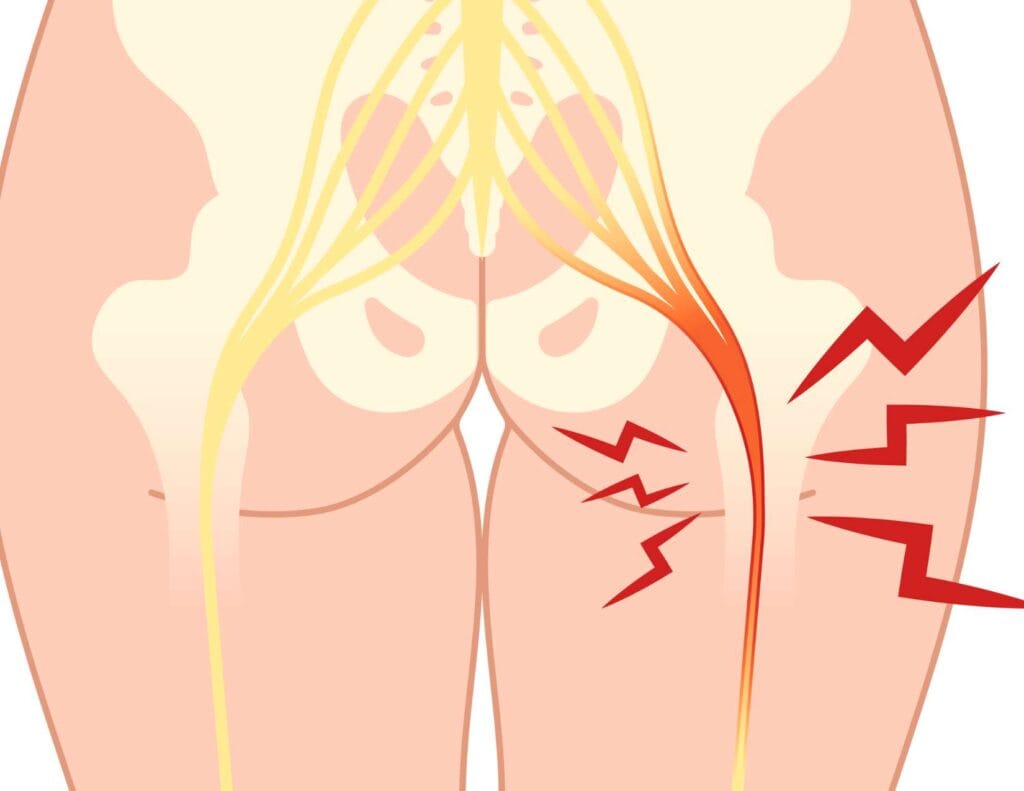
The Connection Between Yoga and Sciatica Relief
As a yoga enthusiast, I’ve always been fascinated by the intricate connection between mind and body. When it comes to sciatica, yoga offers a holistic approach to pain management and healing.
The practice of yoga combines physical postures, breathing techniques, and mindfulness, all of which contribute to alleviating sciatica symptoms.
Yoga works on multiple levels to provide relief:
- Physical: Yoga poses help stretch and strengthen the muscles supporting the spine, reducing pressure on the sciatic nerve.
- Neurological: The practice stimulates the nervous system, promoting better communication between the brain and affected areas.
- Circulatory: Improved blood flow to the affected regions aids in healing and reduces inflammation.
- Mental: Stress reduction through yoga practice can help manage pain perception and improve overall well-being.
By incorporating yoga into your routine, you’re not just treating the symptoms but addressing the root causes of sciatica. This holistic approach sets yoga apart from other forms of treatment and makes it an excellent complementary therapy for sciatica sufferers.
Top 5 Yoga Poses for Sciatica Pain Management
In my years of teaching yoga, I’ve found certain poses to be particularly effective in managing sciatica pain.
Here are my top 5 recommendations:
- Pigeon Pose (Eka Pada Rajakapotasana)
- Stretches the piriformis muscle and opens the hips
- Hold for 30 seconds to 1 minute on each side
- Modify by using a folded blanket under the hip for support
- Cobra Pose (Bhujangasana)
- Strengthens the lower back and improves spinal flexibility
- Hold for 15-30 seconds, repeating 3-5 times
- Focus on lifting with your back muscles, not pushing with your arms
- Child’s Pose (Balasana)
- Gently stretches the lower back and promotes relaxation
- Hold for 1-3 minutes, breathing deeply
- Widen knees for a deeper stretch in the hips
- Seated Spinal Twist (Ardha Matsyendrasana)
- Improves spinal mobility and stretches the piriformis
- Hold for 30 seconds to 1 minute on each side
- Keep your spine long and twist from the base of your spine
- Cat-Cow Pose (Marjaryasana-Bitilasana)
- Increases spinal flexibility and strengthens core muscles
- Perform 10-15 cycles, moving with your breath
- Focus on the full range of motion in your spine
Practicing yoga for sciatica regularly helps strengthen the muscles around the spine, providing more stability and support.
Many individuals find that yoga for sciatica not only reduces pain but also improves their overall flexibility and mobility.
Remember, consistency is key when practicing these poses. Incorporate them into your daily routine for maximum benefit.
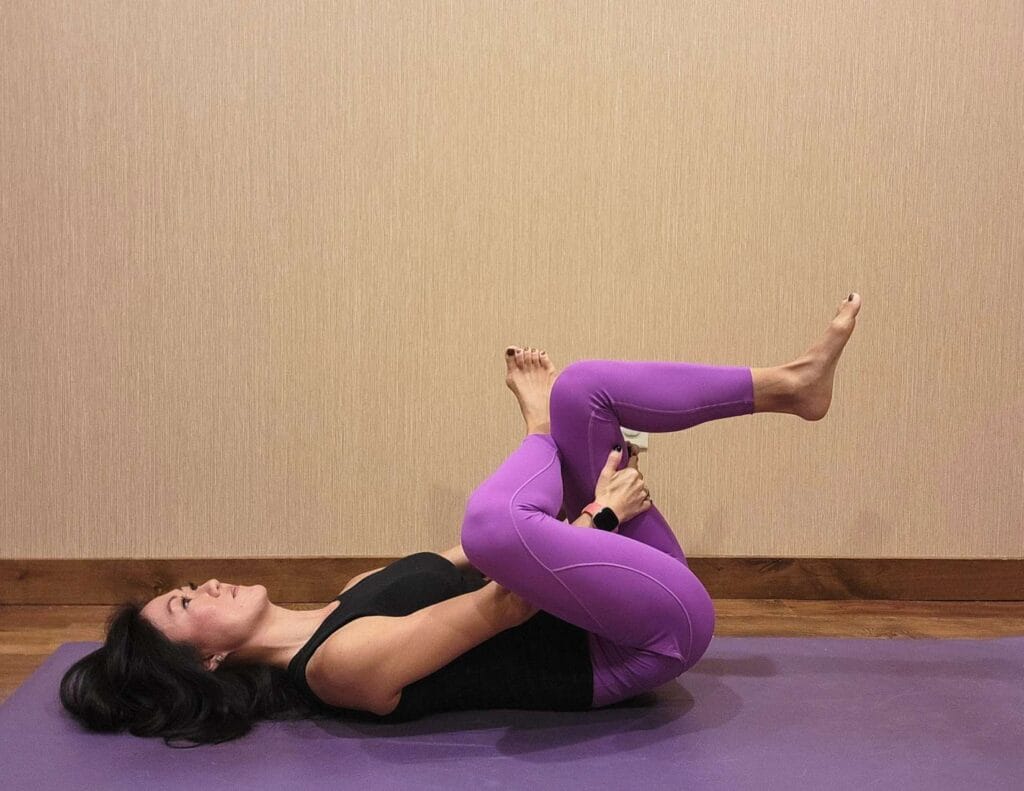
Gentle Yoga Stretches to Ease Sciatica Discomfort
While the previous poses are excellent for managing sciatica pain, sometimes a gentler approach is needed, especially during acute flare-ups.
Here are some soothing stretches that can provide relief:
- Supine Figure Four Stretch
- Lie on your back, cross one ankle over the opposite knee
- Gently pull the uncrossed leg towards your chest
- Hold for 30 seconds to 1 minute, then switch sides
- Knee to Chest Pose
- Lie on your back and hug one knee to your chest
- Hold for 30 seconds, then switch legs
- For a deeper stretch, bring both knees to your chest
- Reclined Spinal Twist
- Lie on your back with arms outstretched in a T-shape
- Bend one knee and cross it over your body
- Turn your head in the opposite direction of your knee
- Hold for 30 seconds to 1 minute on each side
These gentle stretches can be performed daily, even multiple times a day, to help alleviate sciatica discomfort. Remember to move slowly and mindfully, never pushing beyond your comfort zone.
Building a Yoga Routine for Sciatica: Frequency and Duration
Yoga for sciatica can be practiced alongside traditional medical treatments for optimal results.
The following yoga for sciatica poses have proven effective for many practitioners.
Developing a consistent yoga practice is crucial for managing sciatica effectively. As someone who has guided many students through this process, I recommend the following approach:
- Frequency: Aim for at least 3-4 yoga sessions per week
- Duration: Start with 15-20 minute sessions, gradually increasing to 30-45 minutes
- Time of day: Practice in the morning to loosen up tight muscles or in the evening to relax before bed
- Intensity: Begin with gentle stretches and slowly incorporate more challenging poses as you build strength and flexibility
Here’s a sample weekly routine:
| Day | Activity |
|---|---|
| Monday | 20-minute gentle yoga session focusing on stretches |
| Tuesday | 30-minute yoga practice incorporating the top 5 poses |
| Wednesday | Rest or light stretching |
| Thursday | 25-minute yoga flow combining gentle and more active poses |
| Friday | 20-minute restorative yoga session |
| Saturday | 40-minute comprehensive yoga practice |
| Sunday | Rest or meditation |
Remember, consistency is more important than intensity. It’s better to practice for shorter durations regularly than to have long, infrequent sessions.
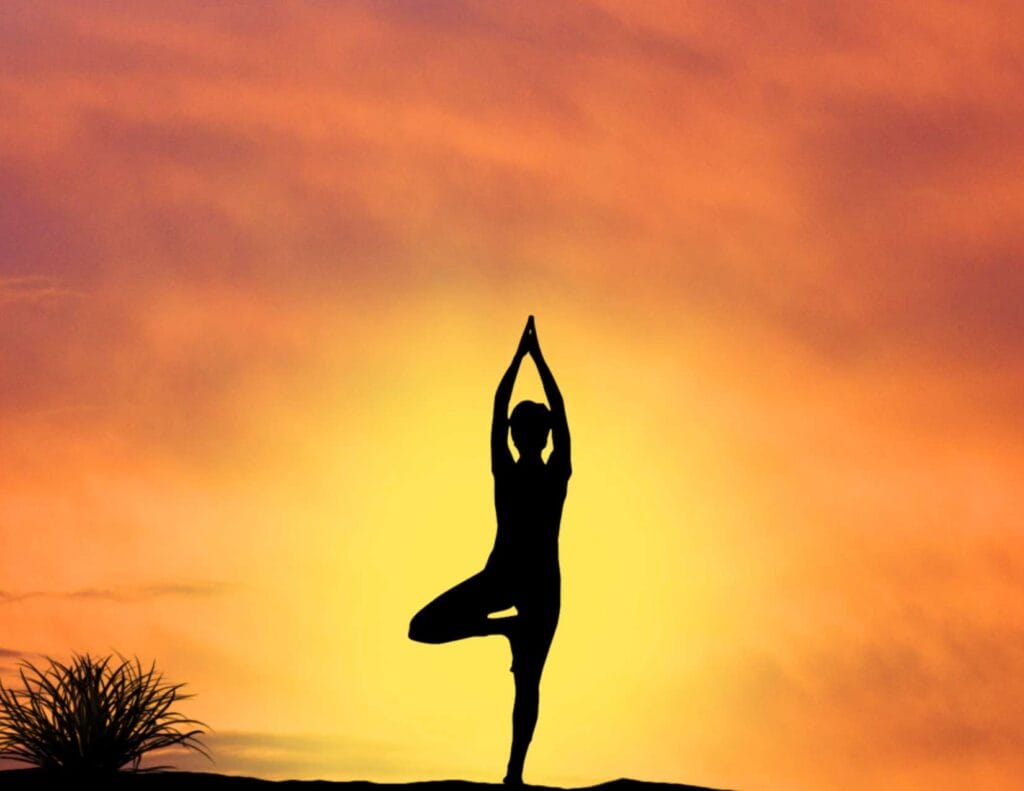
Precautions and Modifications for Practicing Yoga with Sciatica
While yoga can be incredibly beneficial for sciatica, it’s essential to approach the practice with caution and awareness. As a yoga instructor, I always emphasize the importance of listening to your body and making necessary modifications.
Here are some key precautions and modifications to keep in mind:
- Avoid forward bends: These can aggravate sciatica by putting pressure on the lower back. Instead, focus on gentle backbends and twists.
- Use props: Blocks, straps, and bolsters can help support your body and make poses more accessible. Don’t hesitate to use them liberally.
- Modify seated poses: If sitting on the floor is uncomfortable, use a chair or practice against a wall for support.
- Be mindful of leg positions: In poses like Pigeon, ensure your leg alignment doesn’t cause any sharp pain or discomfort.
- Go slow: Take your time moving in and out of poses, and never force your body into a position that causes pain.
Remember, yoga should never cause pain. If you experience any sharp or intense discomfort during practice, ease out of the pose immediately and consult with a healthcare professional or experienced yoga instructor.
Complementary Yoga Exercises for Sciatica Recovery
In addition to specific yoga poses, there are complementary exercises and techniques that can enhance your sciatica recovery. I often incorporate these into my classes to provide a well-rounded approach:
- Core strengthening exercises:
- Plank pose variations
- Bridge pose
- Bird-dog pose
- Hip openers:
- Butterfly stretch
- Low lunge with a twist
- Happy baby pose
- Breathing exercises (Pranayama):
- Diaphragmatic breathing
- Alternate nostril breathing
- Lion’s breath
- Meditation and mindfulness:
- Body scan meditation
- Loving-kindness meditation
- Mindful walking
These complementary practices work synergistically with yoga poses to promote healing, reduce stress, and improve overall well-being. Incorporating them into your routine can accelerate your recovery and provide additional tools for managing sciatica symptoms.
The Science Behind Yoga’s Effectiveness in Treating Sciatica
As both a yoga practitioner and a chiropractor, I find the research supporting yoga’s effectiveness in treating sciatica fascinating. Several studies have demonstrated the positive impact of yoga on sciatica symptoms:
- A 2017 study published in the Annals of Internal Medicine found that yoga was as effective as physical therapy in reducing chronic low back pain, which often includes sciatica.
- Research in the Journal of Pain Research showed that yoga significantly improved pain and functional disability in patients with chronic low back pain and sciatica.
- A systematic review in the Journal of Orthopaedic & Sports Physical Therapy concluded that yoga can be an effective adjunct treatment for chronic low back pain and sciatica.
The scientific mechanisms behind yoga’s effectiveness include:
- Increased flexibility and range of motion in the spine and hips
- Improved core strength, providing better support for the lower back
- Enhanced blood circulation, promoting healing and reducing inflammation
- Activation of the parasympathetic nervous system, reducing stress and pain perception
These findings underscore the value of incorporating yoga into a comprehensive sciatica treatment plan.
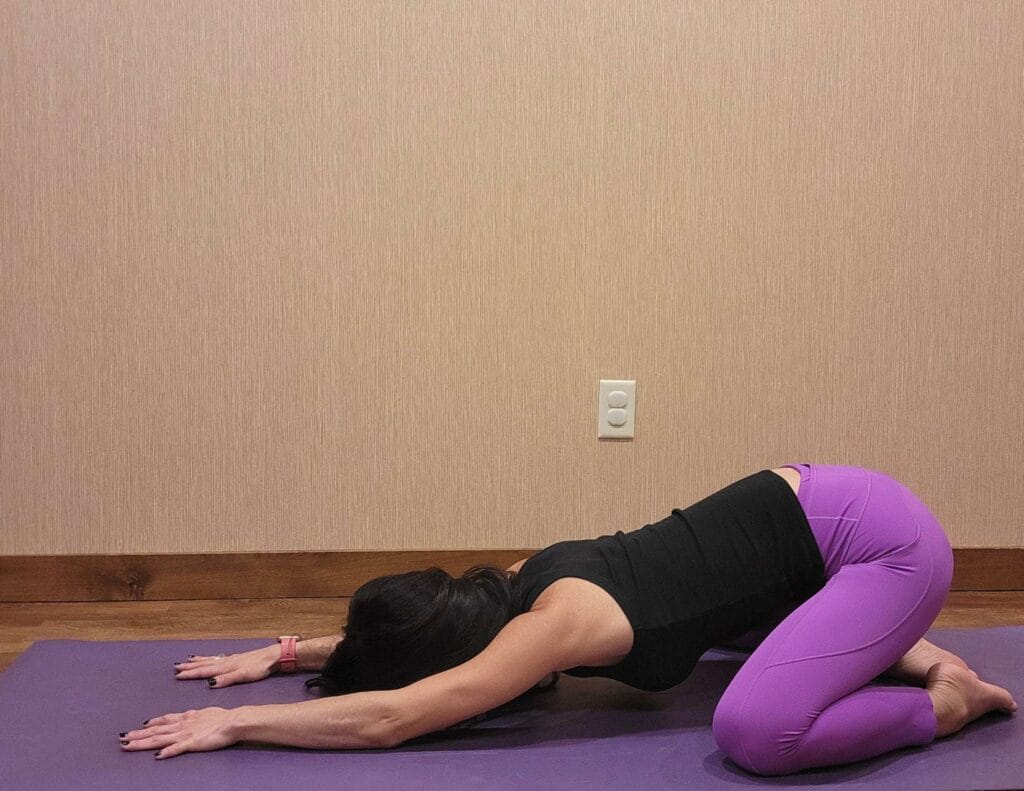
Integrating Yoga into Your Overall Sciatica Treatment Plan
While yoga can be a powerful tool for managing sciatica, it’s important to view it as part of a holistic treatment approach. In my experience, the most effective sciatica management plans incorporate multiple strategies. Here’s how you can integrate yoga into your overall treatment:
- Consult with healthcare professionals: Work with your doctor, physical therapist, or chiropractor to ensure yoga complements your existing treatment.
- Combine with other therapies: Use yoga alongside other treatments like massage, acupuncture, chiropractic or heat/cold therapy for comprehensive relief.
- Address lifestyle factors: Incorporate ergonomic improvements at work, maintain good posture, and consider dietary changes to reduce inflammation.
- Gradual progression: Start with gentle yoga and gradually increase intensity as your symptoms improve and your healthcare provider approves.
- Regular check-ins: Monitor your progress and adjust your yoga practice as needed based on how your body responds.
Remember, everyone’s journey with sciatica is unique. Be patient with yourself and celebrate small improvements along the way.
Expert Tips for Maximizing the Benefits of Yoga for Sciatica
As someone who has guided numerous individuals through their yoga journey for sciatica relief, I’ve gathered some expert tips to help you maximize the benefits of your practice:
- Practice mindfulness: Stay present and aware during your yoga sessions, focusing on the sensations in your body.
- Use proper alignment: Pay attention to your form in each pose to prevent further injury and maximize benefits.
- Breathe deeply: Incorporate deep, diaphragmatic breathing to relax tense muscles and reduce pain.
- Be consistent: Regular practice, even if brief, is more beneficial than sporadic, lengthy sessions.
- Listen to your body: Honor your limits and avoid pushing through pain.
- Stay hydrated: Drink plenty of water before and after your practice to support muscle function and recovery.
- Warm up properly: Begin each session with gentle movements to prepare your body for more challenging poses.
- Cool down and rest: End your practice with restorative poses and take time to relax afterward.
- Keep a yoga journal: Track your progress, noting which poses feel most beneficial and any changes in your symptoms.
- Seek guidance: Don’t hesitate to work with a qualified yoga instructor who has experience with sciatica.
By implementing these tips, you’ll create a more effective and enjoyable yoga practice tailored to your sciatica needs.
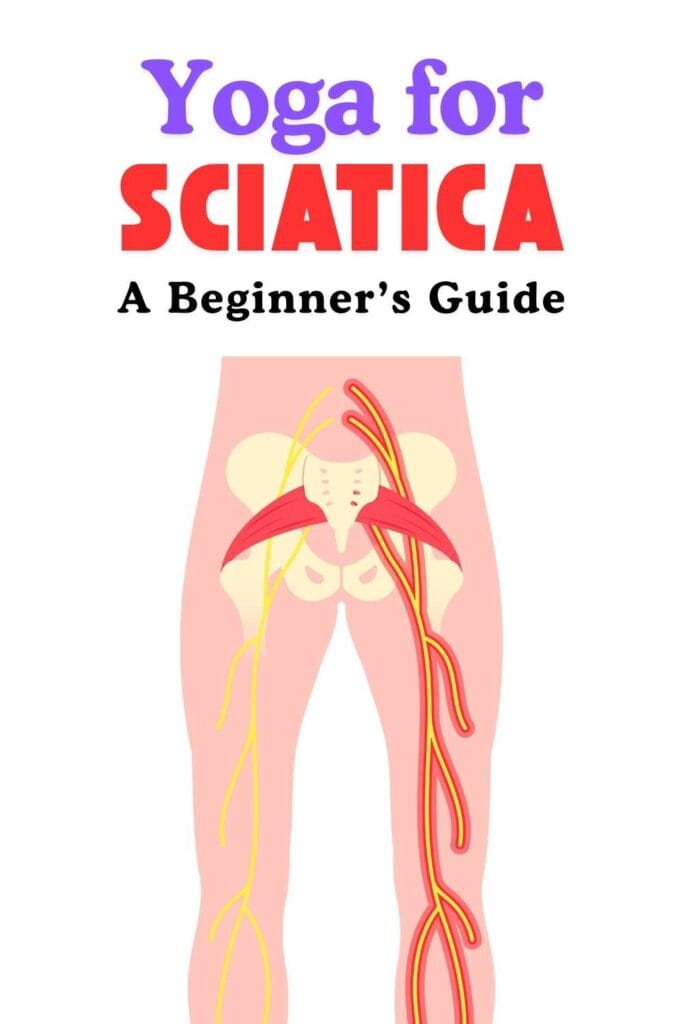
Conclusion: Embracing Yoga as a Natural Remedy for Sciatica
As we conclude this exploration of yoga for sciatica, I hope you’ve gained valuable insights into how this ancient practice can provide relief and promote healing.
From understanding the causes of sciatica to learning specific poses and building a consistent routine, we’ve covered a comprehensive approach to managing this challenging condition through yoga.
Gentle yoga stretches for sciatica are designed to be accessible and soothing for all levels.
Remember, the journey to recovery is often gradual, but with patience and dedication, yoga can be a powerful tool in your sciatica management toolkit. By embracing yoga as a natural remedy, you’re not just addressing the physical symptoms but also nurturing your overall well-being.
As you move forward, listen to your body, stay consistent with your practice, and don’t hesitate to seek guidance when needed. With time and practice, you may find that yoga not only alleviates your sciatica symptoms but also brings a sense of balance, strength, and peace to your life.
Ready to start your yoga journey for sciatica relief? I invite you to try a gentle yoga session today. Begin with just 10 minutes of practice, focusing on the gentle stretches we’ve discussed. As you experience the benefits, gradually increase your practice time and explore more poses. Remember, every step on this path is a step towards healing.
Namaste!






